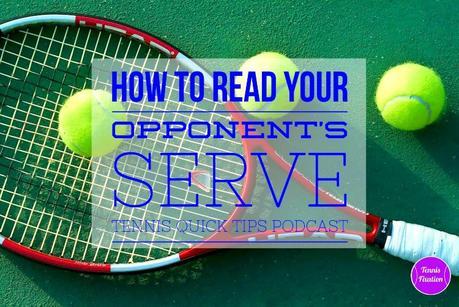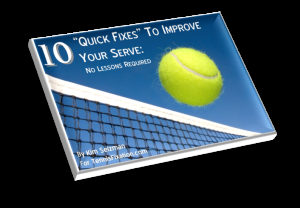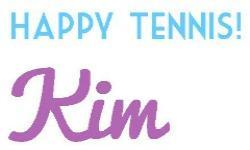Podcast: Play in new window | Download
Do you know how to "read" your opponent's serve? Do you think that's even possible? Are you a fan of the 2004 tennis movie, "Wimbledon"? In this episode of Tennis Quick Tips, I'll give you my best tips to help you read your opponent's serve and I'll tell you why I think Wimbledon is actually a pretty good tennis movie. You can listen to this episode by clicking on the media player above or by listening in with your favorite podcast app. You can also subscribe in iTunes by clicking on this link: tennisfixation.com/itunes.

SHOW NOTES
Can You Read Your Opponent's Serve?
Before I get going, I want to admit something to you about the topic we're discussing today. I think this topic - how to read your opponent's serve - is pretty high-level stuff. The kind of stuff that really advanced players think about and do when they're playing. Definitely the pros do this, or attempt to do this, and when you're watching the Slams on T.V., you'll often hear the commentators mention this. Like, "Oh, he knew exactly where that serve was coming." Or, "Well, she guessed wrong on that one."
But I think even players who are at an intermediate, or even an advanced beginner, level can, in fact, read their opponent's serve. And, just in case you're not 100% sure what I'm talking about, to read your opponent's serve means to figure out what kind of serve they're going to hit. Which obviously would be a great thing to know as the returner.
Anyway, I think I've always made it clear that I'm a regular, recreational tennis player like I believe most of you who are listening are. But even I myself do think about reading my opponent's serve when I'm playing a match and getting ready to return. So I'm going to give you some tips on how any player can read his or her opponent's serve. But first let me tell you how this issue came up for me and then let me tell you about one of my favorite tennis movies.
The issue of reading an opponent's serve came up in an email I got from Tennis Quick Tips listener Lorna. Lorna had this to say:
Hi Kim - I am a regular listener and really enjoy your lessons. I was listening to your last episode 118 and then listened to number 30 again. You mentioned that you can tell what kind of serve you will receive. Honestly, I don't think I can really know what kind of serve I will receive only that it will be a fast one! Can you explain how to read the serve? Thanks - Lorna
First, I want to thank Lorna for sending her question and point out this is Lorna's second question to be answered in a Tennis Quick Tips Episode. She emailed me previously, in fact we've had a few exchanges, and I did an episode all about communicating with your doubles partner in response to a previous email from her. That was Episode 109, Call It! Communicating with Your Doubles Partner During Points, and I'll link to that in the show notes for this episode which you can find at http://tennisfixation.com/quicktips121.
Anyway, the two episodes that Lorna mentioned in this email were all about returns. Episode 118 was called Are You Giving Away Points On Your Return? and Episode 30 was How to Hit a Better Return. And again, I'll have links to those episodes in the show notes. And in those episodes I gave some tips for how to hit a better return and the type of mindset you need to have when you're about to return.
But Lorna's question also goes to the return - is there some way we can read our opponent's serve so that we know what kind of serve is coming at us and can hit an even better return?
I Love the 2004 Movie "Wimbledon"
Now here's where the part about one of my favorite tennis movies comes in. That movie is Wimbledon, made in 2004 and starring Kirsten Dunst and Paul Bettany. I know that isn't necessarily everyone's favorite tennis movie but, if you are not a fan of that movie, I hope you'll keep listening to see how I'm able to tie that movie into today's topic. And warning - I'm going to throw in a few spoilers here.
Anyway, in the movie, Paul Bettany is an English tennis pro who somehow makes it into the finals of Wimbledon despite his ranking of 119 when the movie starts. He falls in love with an up and coming American tennis star played by Kirsten Dunst. During the finals, he kind of falls apart and is sure he is about to lose the match. But on a bathroom break, he is visited in the locker room by Kirsten Dunst who tells him that she loves him, of course, and also that he isn't doing a very good job of reading his opponent's serve. She flat out says that the opponent's serve is "like a book, you just have to know how to read it." She then points out that if the opponent bounces the ball twice before serving, he's going for the body serve. And if he lifts his toe, it means he's going to serve deep.
And of course, she's right and Paul Bettany finally gets his mojo back and ends of winning Wimbledon and retiring at the top of his game and ending up with Kirsten Dunst and it's all wonderful. So a very sweet movie that has some great tennis stuff in it.
But Can I Read My Opponent's Serve If I'm Not A Tennis Pro?
Anyway, this whole concept of reading the serve like that, being able to see the tells of an opponent and knowing what serve was about to come was really interesting to me. But, to be honest, I didn't think this was the type of skill someone like me could ever acquire. For one thing, I play different opponents all the time. I don't come up against the same people very often.
For another thing, the types of clues in the movie and that we're often told to use to help us read the serve are either hard to detect or are happening very quickly. The typical clues you are told to look for are what kind of toss is your opponent using? What swing path is their racket taking? What is the racket face orientation on contact? Frankly, I don't really have the quickness or the mental ability to consciously absorb things like this unless they are incredibly obvious. I'm usually much more concerned with focusing on my own return than on counting the number of times that my opponent bounces the ball.
But there is good news here. And that is reading your opponent's serve is not as complicated as it sounds. There are a few very simple things that we recreational players can do to help us "read" our opponent's serve. And they don't involve watching swing paths, racket face orientations, or your opponent's toes.
So, how can we read our opponent's serve to help us hit a better return?
Clue No. 1 - What Is Your Opponent's Serve History?
The first thing you can use to help you read your opponent's serve is their serve history. In other words, what kind of serves are they hitting to you already? Although we are all told to change things up, move our serve around and keep our opponents guessing, the truth is that many, many people will pretty much hit you the same serves over and over throughout a match. They may have a different first serve and second serve but, often, that's it. They will hit the same first serve and then the same second serve throughout the match. And I mean exactly the same. Same type of spin. Same target. Same pace. I do this very thing even though I know I shouldn't be so predictable when I'm serving. But I tend to fall back on my most reliable serves at some point in the match, especially if the match goes into a third set and I get mentally or physically tired. And a lot of other players, probably most players, do this too.
So the first thing you can use to help you read your opponent's serve is their serve history. Figure out what serves they've been giving you so far and expect that those same types of serves are going to keep coming.
Clue No. 2 - What Is Your Opponent's Position On The Baseline?
The second thing you can look to is your serving opponent's position on the baseline. You may already know this, but just as a refresher, usually, if your opponent stands very close to the center mark on the baseline when they're serving, that signals that they're going to serve up the middle. Because hitting an up the middle serve from that position keeps the ball traveling up the middle. If they stand closer to the singles side line, or even out in the doubles alley, to serve, that usually signals that they're going to serve out wide. Again, it's because that gives them a lot more room to hit that out wide serve by standing in that exaggerated position. I talked about this issue, where to stand when you serve, in a previous Tennis Quick Tips episode - Episode 103 which was called Simple Serve Tips: Where You Should Stand When You Serve - and I'll link to that in the show notes.
Now, just be aware, these positions usually signal that a particular type of serve is coming. But not always. Some servers can hit a variety of targets from wherever they stand on court. And in that case, you need to fall back on the first thing I talked about - what is the serving history of this server during the match? But, just know that the position a server takes on the baseline is another clue that can help you read your opponent's serve.
Clue No. 3 - What Is Happening In The Match?
The third clue you can use to help read your opponent's serve is to think about what is happening in the match. If you have a great partner who poaches like crazy every time you're receiving, then the server may try to serve out wide as much as possible to avoid that poacher. Similarly, if the server has a great partner who poaches like crazy, the server may try to serve up the middle as much as possible to set his or her partner up to poach. Or maybe you've shown that you have a particularly weak return on your backhand side, for example. In that case, I would expect the server to keep trying to serve to your backhand. So look at what is happening in your match to see if you can figure out what the server is doing in response and use that as a clue to help read your opponent's serve.
Clue No. 4 - Just Get In The Ready Position
The final thing I would say is just to be ready. This isn't really a clue from your opponent but it's something you can do to help get ready for any serve your opponent hits. Just be in the ready position. If you really aren't sure what kind of serve is going to come at you, then get yourself in a good, athletic ready stance so that you're ready to react immediately to whatever serve is hit. I talked about the ready position in Episode 31 of Tennis Quick Tips which is How to Use the Tennis Ready Position and of course I'll have a link to that in the show notes.
So those are the four things I think you should look for or be aware of when trying to read your opponent's serve. Again, those were:
- the serving history of the server during the match,
- the baseline position that the server takes when serving,
- what is happening during the match that might influence the server, and
- taking the ready position to be ready for any serve.
I want to thank Lorna for sending in another great question to me. I have a form on TennisFixation.com where you can contact me or you can leave a comment in the show notes for this episode and that's where you can ask me your own tennis questions. I love to get them so please feel free to do that.
RESOURCES AND LINKS FROM THIS EPISODE
For more information, check out these Tennis Quick Tips episodes:
SHARE, SUBSCRIBE AND REVIEW
Thanks so much for being a listener and friend of the Tennis Quick Tips podcast. And I hope you'll consider sharing this podcast with your friends and leaving a review of the show as it really helps it to be found by other like-minded tennis players. You can listen in, subscribe or leave a review by going to:
GET A BETTER SERVE FAST!
And if you're interested in getting a better serve - fast! - get my free ebook, 10 Quick Fixes to Improve Your Serve: No Lessons Required.
By applying the 10 simple tips to your serve that I give in this ebook, your serve can become a tool that you can use to gain control of points. It can become more powerful, more accurate, and something you're actually proud of. Just enter your email below and you'll get instant access to this free ebook as well as weekly updates with all of my best tennis tips!

© Kim Selzman 2016 All Rights Reserved
Full disclosure - Some of the links in this post are Amazon affiliate links. I make a very small commission if you purchase any item using my Amazon affiliate links. Your cost is the same for these items whether or not you use these links. This does not influence my opinion of these items and I always tell the absolute truth about every item that I review. I usually do not review items that I don't like.

